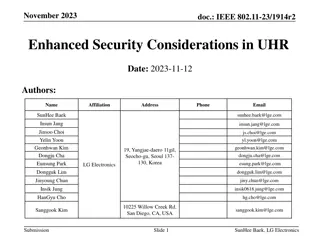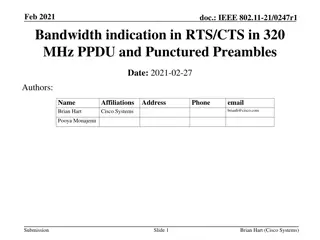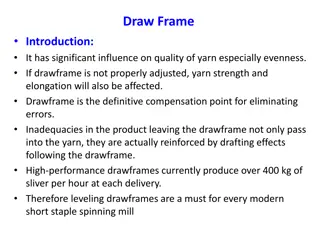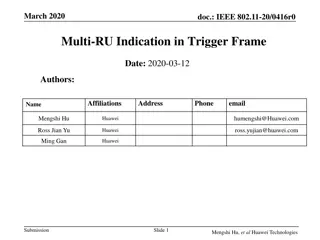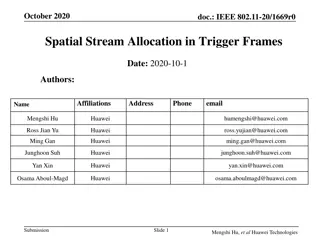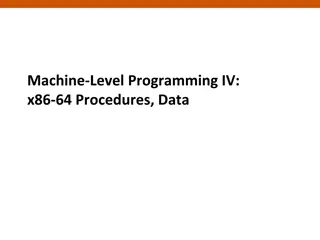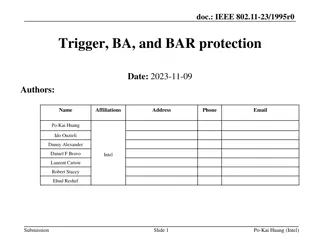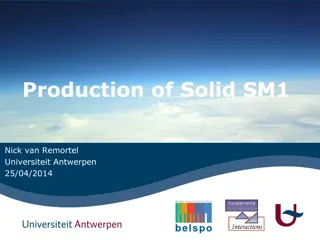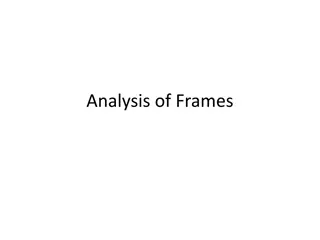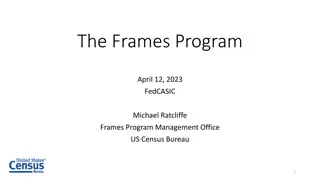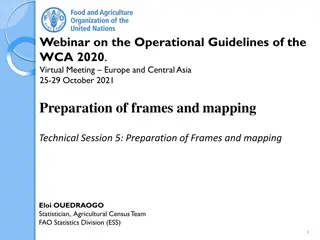
Virtual Memory Designated Initializer Tips
Dive into the world of virtual memory with designated initializers in operating systems. Learn how to initialize structs, avoid garbage values, and manage memory efficiently. Explore valuable tips and visualize memory frames for a better understanding.
Download Presentation

Please find below an Image/Link to download the presentation.
The content on the website is provided AS IS for your information and personal use only. It may not be sold, licensed, or shared on other websites without obtaining consent from the author. If you encounter any issues during the download, it is possible that the publisher has removed the file from their server.
You are allowed to download the files provided on this website for personal or commercial use, subject to the condition that they are used lawfully. All files are the property of their respective owners.
The content on the website is provided AS IS for your information and personal use only. It may not be sold, licensed, or shared on other websites without obtaining consent from the author.
E N D
Presentation Transcript
Welcome to CS 345 Operating Systems Virtual Memory (23)
Tip #23: Designated Initializer 2 Virtual Memory (23) typedef struct Item { int a; float b; char* name; } Item; If you initialize even one object / variable in the struct, all of its other variables will be initialized to default value. If no values are initialized, all variables will contain "garbage values" (if local). int main(void) { Item item = {5, 2.2, "Tom"}; return 0; } .name = "Tom", .a = 5 }; return 0; } int main(void) { Item item = { .b = 2.2, Or you can use a designated initializer (in any order.) Omitted fields members of global or static type are implicitly initialized.
Virtual Memory (23) Virtual Memory 3
8 Frames... 0x3040 ?? 4 Virtual Memory (23) x3000 (192) FR____|S____ Frame Page 10_199|1___0 0xxxxx|1___1 ... 00____|0____ Disk Storage x2400 RPT0 Virtual Address 0x3000 0x3001 0x3040 0x3041 0xEFD2 0xD851 0xD833 0x3873 0x3000 0xF7C5 0xEFF0 0xD807 0x3040 Physical Address 0x3040 0x3041 0x3080 0x3081 0x3112 0x3191 0x31F3 0x30B3 0x31C0 0x3145 0x3130 0x3047 00____|0____ 00____|0____ 00____|0____ 00____|0____ 00____|0____ 00____|0____ 10_192|0____ 0xxxxx|1___6 ... 11_194|1___4 00____|0____ 10_195|0____ 10_198|0____ 00____|0____ x0000 x07FF x0000 x07FF x0800 x0FFF x0800 x0FFF x3040 (193) x1000 x17FF x1000 x17FF xD800-xD83F Data Frame x1800 x1FFF x1800 x1FFF x2000 x27FF x2000 x27FF x3080 (194) x2800 x2FFF x2800 x2FFF 11_193|1___2 0xxxxx|1___3 ... 00____|0____ #0 x3000 #1 x3040 #2 xD800 #3 xD840 #4 UPT1 #5 x3800 #6 UPT2 x3000 x37FF x3000 x37FF x3800 x3FFF x3800 x3FFF x30C0 (195) ... ... 00____|0____ 00____|0____ ... 10_196|0____ xD800 xDFFF xD800 xDFFF xE000 xE7FF xE000 xE7FF xE800 xEFFF xE800 xEFFF x3100 (196) xF000 xF7FF xF000 xF7FF xEF80-xEFFF Data Frame xF800 xFFFF xF800 xFFFF x2440 RPT1 00____|0____ 00____|0____ 00____|0____ 00____|0____ ... x3140 (197) xF740-xF7FF Data Frame x3180 (198) 00____|0____ 00____|0____ ... 10_197|0____ x31C0 (199) x3000-x303F Data Frame x3200
8 Frames... 5 Virtual Memory (23) x3000 (192) FR____|S____ Frame Page 10_199|1___0 0xxxxx|1___1 ... 00____|0____ Disk Storage x2400 RPT0 11_196|1___1 Virtual Address 0x3000 0x3001 0x3040 0x3041 0xEFD2 0xD851 0xD833 0x3873 0x3000 0xF7C5 0xEFF0 0xD807 0x3040 Physical Address 0x3040 0x3041 0x3080 0x3081 0x3112 0x3191 0x31F3 0x30B3 0x31C0 0x3145 0x3130 0x3047 0x3100 00____|0____ 00____|0____ 00____|0____ 00____|0____ 00____|0____ 00____|0____ 10_192|0____ 0xxxxx|1___6 ... 11_194|1___4 00____|0____ 10_195|0____ 10_198|0____ 00____|0____ x0000 x07FF x0000 x07FF x0800 x0FFF x0800 x0FFF x3040 (193) x1000 x17FF x1000 x17FF xD800-xD83F Data Frame x1800 x1FFF x1800 x1FFF x2000 x27FF x2000 x27FF x3080 (194) x2800 x2FFF x2800 x2FFF 11_193|1___2 0xxxxx|1___3 ... 00____|0____ #0 x3000 #1 x3040 #2 xD800 #3 xD840 #4 UPT1 #5 x3800 #6 UPT2 #7 xEF80 11_192 x3000 x37FF x3000 x37FF x3800 x3FFF x3800 x3FFF x30C0 (195) ... ... 00____|0____ 00____|0____ ... 10_196|0____ 0xxxxx|1___7 10_194 xD800 xDFFF xD800 xDFFF xE000 xE7FF xE000 xE7FF xE800 xEFFF xE800 xEFFF x3100 (196) xF000 xF7FF xF000 xF7FF x3040-x307F xEF80-xEFFF Data Frame Data Frame xF800 xFFFF xF800 xFFFF x2440 RPT1 00____|0____ 00____|0____ 00____|0____ 00____|0____ ... x3140 (197) xF740-xF7FF Data Frame x3180 (198) 00____|0____ 00____|0____ ... 10_197|0____ x31C0 (199) x3000-x303F Data Frame x3200
8 Frames... 6 Virtual Memory (23) x3000 (192) FR____|S____ Frame Page 10_199|1___0 11_196|1___1 ... 00____|0____ Disk Storage x2400 RPT0 Virtual Address 0x3000 0x3001 0x3040 0x3041 0xEFD2 0xD851 0xD833 0x3873 0x3000 0xF7C5 0xEFF0 0xD807 0x3040 0xFFC8 Physical Address 0x3040 0x3041 0x3080 0x3081 0x3112 0x3191 0x31F3 0x30B3 0x31C0 0x3145 0x3130 0x3047 0x3100 0x3148 00____|0____ 00____|0____ 00____|0____ 00____|0____ 00____|0____ 00____|0____ 11_192|0____ 0xxxxx|1___6 ... 10_194|1___4 00____|0____ 10_195|0____ 10_198|0____ 00____|0____ 11_195 x0000 x07FF x0000 x07FF x0800 x0FFF x0800 x0FFF x3040 (193) x1000 x17FF x1000 x17FF xD800-xD83F Data Frame x1800 x1FFF x1800 x1FFF x2000 x27FF x2000 x27FF x3080 (194) x2800 x2FFF x2800 x2FFF 11_193|1___2 0xxxxx|1___3 ... 00____|0____ 00____|0____ 00____|0____ ... #0 x3000 #1 x3040 #2 xD800 #3 xD840 #4 UPT1 #5 x3800 #6 UPT2 #7 xEF80 #8 UPT3 #9 F740 x3000 x37FF x3000 x37FF x3800 x3FFF x3800 x3FFF x30C0 (195) ... ... 00____|0____ 00____|0____ ... 0xxxxx|1___7 00____|0____ 11_197|0____ xD800 xDFFF xD800 xDFFF xE000 xE7FF xE000 xE7FF 0xxxxx|1___8 xE800 xEFFF xE800 xEFFF x3100 (196) xF000 xF7FF xF000 xF7FF x3040-x307F Data Frame xF800 xFFFF xF800 xFFFF x2440 RPT1 00____|0____ 00____|0____ 00____|0____ 00____|0____ ... x3140 (197) xFFC0-xFFFF xF740-xF7FF Data Frame Data Frame x3180 (198) 00____|0____ 00____|0____ ... 10_197|0____ 0xxxxx|1___9 x31C0 (199) x3000-x303F Data Frame x3200
8 Frames... 7 Virtual Memory (23) x3000 (192) FR____|S____ Frame Page 10_199|1___0 11_196|1___1 ... 00____|0____ 11_199|1___0 Disk Storage x2400 RPT0 Virtual Address 0x3000 0x3001 0x3040 0x3041 0xEFD2 0xD851 0xD833 0x3873 0x3000 0xF7C5 0xEFF0 0xD807 0x3040 0xFFC8 0x303C Physical Address 0x3040 0x3041 0x3080 0x3081 0x3112 0x3191 0x31F3 0x30B3 0x31C0 0x3145 0x3130 0x3047 0x3100 0x3148 0x31FC 00____|0____ 00____|0____ 00____|0____ 00____|0____ 00____|0____ 00____|0____ 11_192|0____ 0xxxxx|1___6 ... 10_194|1___4 00____|0____ 0xxxxx|1___8 10_198|0____ 11_195|0____ x0000 x07FF x0000 x07FF x0800 x0FFF x0800 x0FFF x3040 (193) x1000 x17FF x1000 x17FF xD800-xD83F Data Frame x1800 x1FFF x1800 x1FFF x2000 x27FF x2000 x27FF x3080 (194) x2800 x2FFF x2800 x2FFF 11_193|1___2 0xxxxx|1___3 ... 00____|0____ 00____|0____ 00____|0____ ... 11_197|0____ #0 x3000 #1 x3040 #2 xD800 #3 xD840 #4 UPT1 #5 x3800 #6 UPT2 #7 xEF80 #8 UPT3 #9 F740 x3000 x37FF x3000 x37FF x3800 x3FFF x3800 x3FFF x30C0 (195) ... ... xD800 xDFFF xD800 xDFFF xE000 xE7FF xE000 xE7FF xE800 xEFFF xE800 xEFFF x3100 (196) xF000 xF7FF xF000 xF7FF x3040-x307F Data Frame xF800 xFFFF xF800 xFFFF x2440 RPT1 00____|0____ 00____|0____ 00____|0____ 00____|0____ ... x3140 (197) xFFC0-xFFFF xF740-xF7FF Data Frame Data Frame x3180 (198) 00____|0____ 00____|0____ ... 0xxxxx|1___9 x31C0 (199) x3000-x303F Data Frame x3200
8 Frames... 8 Virtual Memory (23) x3000 (192) FR____|S____ Frame Page 11_199|1___0 11_196|1___1 ... 00____|0____ 10_199 10_196 Disk Storage x2400 RPT0 Virtual Address 0x3000 0x3001 0x3040 0x3041 0xEFD2 0xD851 0xD833 0x3873 0x3000 0xF7C5 0xEFF0 0xD807 0x3040 0xFFC8 0x303C 0xF000 Physical Address 0x3040 0x3041 0x3080 0x3081 0x3112 0x3191 0x31F3 0x30B3 0x31C0 0x3145 0x3130 0x3047 0x3100 0x3148 0x31FC 0x3040 00____|0____ 00____|0____ 00____|0____ 00____|0____ 00____|0____ 00____|0____ 11_192|0____ 0xxxxx|1___6 ... 10_194|1___4 00____|0____ 0xxxxx|1___8 10_198|0____ 11_195|0____ 10_195 x0000 x07FF x0000 x07FF x0800 x0FFF x0800 x0FFF x3040 (193) x1000 x17FF x1000 x17FF xF000-xF03F xD800-xD83F Data Frame Data Frame x1800 x1FFF x1800 x1FFF x2000 x27FF x2000 x27FF x3080 (194) x2800 x2FFF x2800 x2FFF 11_193|1___2 0xxxxx|1___3 ... 00____|0____ 00____|0____ 00____|0____ ... 11_197|0____ 10_197 10_193 0xxxxx #0 x3000 #1 x3040 #2 xD800 #3 xD840 #4 UPT1 #5 x3800 #6 UPT2 #7 xEF80 #8 UPT3 #9 F740 10_192 x3000 x37FF x3000 x37FF x3800 x3FFF x3800 x3FFF x30C0 (195) ... ... xD800 xDFFF xD800 xDFFF xE000 xE7FF xE000 xE7FF xE800 xEFFF xE800 xEFFF x3100 (196) 11_198 10_198 11_198 xF000 xF7FF xF000 xF7FF x3040-x307F Data Frame xF800 xFFFF xF800 xFFFF x2440 RPT1 00____|0____ 00____|0____ 00____|0____ 00____|0____ ... x3140 (197) xFFC0-xFFFF xF740-xF7FF Data Frame Data Frame x3180 (198) 00____|0____ 00____|0____ ... 0xxxxx|1___9 11_193 x31C0 (199) x3000-x303F Data Frame x3200
1. What is the purpose of the variable tcb[curTask].RPT? 1. Each task 2. What is the purpose of line 005? has its own RPT. 2. Turn MMU off for system memory. 3. Root directory entries. rpte1 = memory frames rpte2 = swap space pages 3. What is the purpose of variables rpte1 and rpte2 ? 4. All frames may be be used for UPT. 4. Why is the function getFrame s parameter -1? 5. Read back a swapped UPT 6. Define all UPT entries by setting values to zero (default). 5. What is the purpose of line 014? 6. What is the purpose of line 017? 7. Prevent the current UPT from being selected as the data frame. 8. New memory is garbage. 7. Why is the function getFrame s parameter rpte1 (line 027)? 8. Why isn t a new data frame initialized (line 031) 9. Memory dirtied by calling function. 9.What is the purpose of lines 35-38?
vma 10 Virtual Memory (23) 2 frames UPT, Frame No new frames Same UPT, new Frame No swap pages New UPT, new Frame Clock did not advance
vma 11 Virtual Memory (23)
Frame Bit Table 14 Virtual Memory (23) 0x3000 0x8000 2 Frames
accessPage 15 Virtual Memory (23) // ************************************************************************* // read/write to swap space int accessPage(int pnum, int frame, int rwnFlg) { static int nextPage; static int pageReads; static int pageWrites; static unsigned short int swapMemory[LC3_MAX_SWAP_MEMORY]; case PAGE_GET_READS: return pageReads; // return swap reads // swap page size // page reads // page writes case PAGE_GET_WRITES: // return swap writes return pageWrites; case PAGE_GET_ADR: return (int)(&swapMemory[pnum<<6]); // return page address if ((nextPage >= LC3_MAX_PAGE) || (pnum >= LC3_MAX_PAGE)) { printf("\nVirtual Memory Space Exceeded! (%d)", LC3_MAX_PAGE); exit(-4); } switch(rwnFlg) { case PAGE_INIT: clockRPT = 0; clockUPT = 0; memAccess = 0; memHits = 0; memPageFaults = 0; nextPage = 0; pageReads = 0; pageWrites = 0; return 0; case PAGE_NEW_WRITE: pnum = nextPage++; // new write case PAGE_OLD_WRITE: memcpy(&swapMemory[pnum<<6], &memory[frame<<6], 1<<7); pageWrites++; return pnum; // write // init paging // clear RPT clock // clear UPT clock // memory accesses // memory hits // memory faults // disk swap space size // disk page reads // disk page writes case PAGE_READ: memcpy(&memory[frame<<6], &swapMemory[pnum<<6], 1<<7); pageReads++; return pnum; // read } // end accessPage } return pnum; case PAGE_FREE: printf("\nPAGE_FREE not implemented"); break; // free page case PAGE_GET_SIZE: return nextPage; // return swap size
Virtual Memory Guidelines 16 Virtual Memory (23) Verify a clean compilation of your LC-3 virtual memory simulator. Validate that crawler.hex and memtest.hex programs execute properly. Modify the getMemAdr() function to handle a 2-level, paging, virtual memory addressing. Implement a clock page replacement algorithm to pick which frame is unloaded, if necessary, on a page fault. Use the provided 1MB page swap table routine to simulate paged disk storage (8192 pages) or implement your own routine. Use crawler.hex and memtest.hex to validate your virtual memory implementation. Use other routines (such as im) to debug you implementation.
Virtual Memory Guidelines 17 Virtual Memory (23) Use the following CLI commands to verify and validate your virtual memory system. (Most of these routines are provided, but may require some adaptation to your system.) dfm <#> Display LC3 memory frame <#> dft Display frame allocation table dm <sa>,<ea> Display physical LC3 memory from <sa> to <ea> dp <#> Display page <#> in swap space dv <sa>,<ea> Display virtual LC3 memory <sa> to <ea> im <#> Init LC3/Set upper LC3 memory limit rpt <#> Display task <#> root page table upt <p><#> Display task <p> user page table <#> vma <a> Access <a> and display RPTE s and UPTE s vms Display LC3 statistics
Virtual Memory Guidelines 18 Virtual Memory (23) Demonstrate that LC-3 tasks run correctly. Be able to dynamically change LC-3 memory size (im command) and chart resulting changes in page hits/faults. Memory accesses, hits and faults are defined as follows: Memory access (memAccess) = sum of memory hits (memHits) and memory faults (memPageFaults). Hit (memHits) = access to task RPT, UPT, or data frame. (Exclude accesses below 0x3000.) Fault (memPageFaults) = access to a task page that is undefined or not currently in a memory frame. Page Reads (pageReads) = # pages read from swap space into memory. Page Writes (pageWrites) = # pages written from memory to swap space. Swap Page (nextPage) = # of swap space pages currently allocated to swapped pages. Crawler 16 Memtest 16 Frames: 320 2 320 2 Accesses: Hits: Faults: Page Reads: Page Writes: Swap Pages:
Project 4 Grading Criteria 19 Virtual Memory (23) REQUIRED: 8 pts Successfully execute crawler and memtest in 20k words (320 frames). 6 pts Successfully execute crawler and memtest in 1k words (16 frames). 2 pts Successfully execute 5 or more LC-3 tasks simultaneously in 16 frames of LC-3 memory. 2 pts Correctly use the dirty bit to only write altered or new memory frames to swap space. 2 pts Chart and submit the resulting memory access, hit, fault, and swap page statistics after executing crawler (and then memtest) in 320 and 16 frames. BONUS: +2 points early pass-off (at least one day before due date.) +2 points Add a per/task frame/swap page recovery mechanism of a terminated task. +1 point Implement the advanced clock algorithm (Stallings, pp. 372-373). +1 point Implement an additional replacement policy and chart the results. +2 points Join the 2-frame club. (Successfully execute 5 or more LC-3 tasks simultaneously in 2 frames of LC-3 memory. Chart the memory accesses, hits, and faults.) 2 points penalty for each school day late.
Steps to Success 20 Virtual Memory (23) 1. Read and comprehend Stallings, Section 8.1. 2. Comprehend the lab specs. a. Discuss questions with classmates, the TA s and/or the professor. b. Make sure you understand what the requirements are! c. It's a tragedy to code for 20 hours and then realize you're doing everything wrong. 3. Validate that the demo LC-3 simulator works for a single task with pass- through addressing (virtual equals physical) for the LC-3 by executing the commands crawler and memtest . 4. Design your MMU. Break the problem down into manageable parts. 5. Create and validate a clock mechanism that accesses all global root page tables, user page tables, and data frames. 6. Implement dirty bit last use write-through for all swapping of a data frame to swap space.
So 21 Virtual Memory (23) 7. Incrementally add support for the actual translation of virtual addresses to physical addresses with page fault detection as follows: a. Implement page fault frame replacement using available memory frames only. This should allow you to execute any test program in a full address space. b. Implement clock page replacement algorithm to unload data frames to swap pages and reload with a new frame or an existing frame from swap space. This should allow you to execute all the test programs in a 32k word address space (20k of paging frames). c. Implement clock page replacement algorithm to unload User Page Tables when there are no physical data frame references in the UPT. This will be necessary when running in a small physical space (16k words) with multiple tasks. d. Implement dirty bit to minimize writing frames to swap space.
Hints 22 Virtual Memory (23) Remember to always increment your clock after finding a replacement frame. Use the vma function to access a single virtual memory location and then display any non-zero RPT and UPT entries. Implement various levels of debug trace to watch what is going on in your MMU. You may use the provided display functions. When swapping a user page table to swap space, add some debug sanity check code to validate that the UPT does not have any entries with the frame bit set.
UPT Clock 23 Virtual Memory (23) 0.14 if (REFERENCED(rpte1)) { rpte1 = CLEAR_REF(rpte1); MEMWORD(rpta) = rpte1; } else { 0.12 0.1 crawler w crawler w/o memTest w memTest w/o 0.08 crawler w 0.08081 0.060116 0.053842 0.05019 0.046726 320 0.0454155 384 0.04298 448 0.042606 512 0.042606 crawler w/o memTest w memTest w/o 0.08174 0.125888 0.059648 0.084417 0.05403 0.066091 0.05019 0.056233 0.047568 0.048995 0.045415 0.041409 0.04298 0.034495 0.042606 0.027209 0.042606 0.019836 16 64 128 192 256 0.13201 0.086761 0.068793 0.058346 0.049912 0.041802 0.034516 0.02755 0.02059 0.06 0.04 0.02 0 16 64 128 192 256 320 384 448 512
Is Virtual Paging A Dead Issue? 24 Virtual Memory (23) Recent revival in page replacement research. Size of primary storage has increased - algorithms that require a periodic check of each and every memory frame are becoming less and less practical. Memory hierarchies have grown taller - the cost of a CPU cache miss is far more expensive. This exacerbates the previous problem. Object-oriented programming techniques have weakened locality of reference. Sophisticated data structures like trees and hash tables and the advent of garbage collection have drastically changed the memory access behavior of applications.
Paging Improvements? 25 Virtual Memory (23) Disk access techniques Use larger blocks. Separate swap space from normal file storage - no file table lookup. Enforce binary boundaries. Load several consecutive sectors/pages rather than individual sectors due to seek, rotational latency. Better Working Set model Monitor program execution minimize number of pages per process are needed for execution (locality). Pre-paging Bring in pages that are likely to be used in the near future. Easier to guess at program startup, but may load unnecessary pages.
Clock Algorithm Enhancements? 26 Virtual Memory (23) Consider reference bit and dirty bit 4 possible cases (Macintosh scheme) (0,0) neither modified or referenced (0,1) not recently used but modified (1,0) recently used but clean (1,1) recently used and modified Still use clock algorithm clear only reference bit upon consideration Add additional reference bits - 3rd, 4th, chance At regular intervals, clear all reference bits A process can be in RAM if and only if all of the pages that it is currently using can be in RAM.
Frame Allocation 27 Virtual Memory (23) Demand allocation Options keep 3 empty frames, write out in background Minimum number of frames what is the least number of frames to allocate Allocation Algorithms equal allocation proportional to storage for executable priority
Global vs Local Allocation 28 Virtual Memory (23) Global Allocation Replacement page is selected from among all pages in system Local Allocation Replacement page is selected only from the pages owned by the process When a page fault occurs, select the page to replace from the resident set of the process that suffered the page fault. Process controls its own page fault rate Number of pages for a process won t grow



